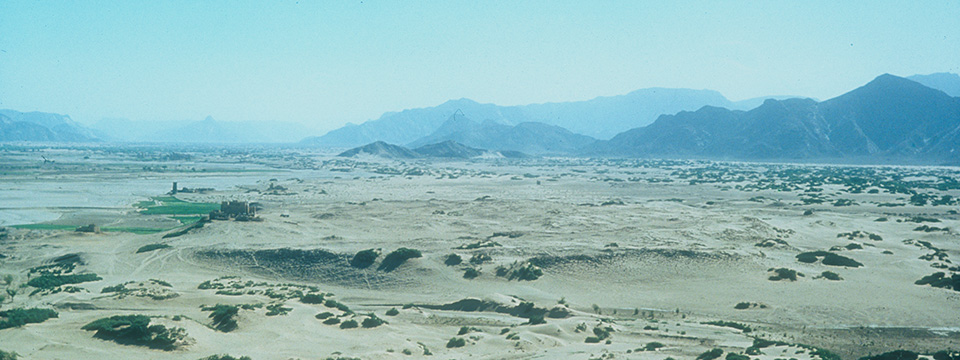In the Dig House: Behind the Scenes in Archaeology

Freer, Meyer Auditorium
Saturday, April 25, 10 am–1:30 pm
Abstracts
Dr. Zaydoon Zaid, vice president, American Foundation for the Study of Man (AFSM), “Uncovering the Past: The Content of AFSM’s Archive”
The AFSM archaeological archive preserves a huge amount of materials from different archaeological sites in South Arabia, mainly Timna and Marib. The records provide evidence that helps us understand the history of those sites. The archive serves as culture’s shared memory and ensures that those archaeological records are organized and available for research.
This talk presents a sampling of the many images from the archive to demonstrate the importance of such records. In addition, these images illustrate the working conditions and labor during the 1950s excavations and compare them with the more recent excavations at Marib.
Dr. Emily Hammer, director, Center for Ancient Middle Eastern Landscapes, Oriental Institute, University of Chicago, “Digital Technologies and Archaeology in the Modern Middle East”
Archaeology has changed a lot since Wendell Phillips’s early 1950s expeditions in Timna. Today’s archaeologists don’t just have photographs and papers recording their excavation adventures; they have satellite images showing ancient road and irrigation networks, geophysical maps of unexcavated city walls beneath the earth’s surface, precise three-dimensional models of ancient houses, and models of how humans might have traveled through ancient streets and landscapes. Recent archaeological work exploring an Iron Age trading center in east Arabia, ancient fortresses in highland Azerbaijan, and networks of movement between Bronze Age cities in Syria shows how archaeologists working in the Middle East use digital technologies to reveal how humans interacted with their natural and built environments. These methodologies improve our ability to envision the lives of urban elites, such as those in ancient Timna, and help us to address new questions about common people and rural societies of the past.
Dr. Christopher Tuttle, executive director, Council of American Overseas Research Centers (CAORC), “Protecting and Preserving the World Heritage Site of Petra, Jordan: Engaging Local Communities in Sustainable Preservation Efforts”
Petra was the capital city of the ancient kingdom of the Nabataeans. Located today in southern Jordan, the ancient city has been a designated UNESCO World Heritage site since 1985. The World Heritage status, combined with its popular designation in 2007 as one of the “New Seven Wonders of the World,” has revived some of Petra’s past glory—in the form of attracting upward of a million visitors a year to tour the site. Yet, this very revival has also greatly increased the threats faced by those trying to maintain the integrity of the many Outstanding Universal Values that make this extensive archaeological and environmental park a World Heritage site.
Petra is fragile, and it is disintegrating. Although various international missions have undertaken conservation and preservation campaigns at the site during the last few decades, none of these efforts have achieved sustainability. A key factor in this failure has been the lack of engaging with and building capacity within the local communities, so that such efforts can be sustained when the international missions eventually leave.
This presentation explores how one innovative project is trying to change this dynamic. The Temple of the Winged Lions Cultural Resource Management Initiative (TWLCRM) is a grassroots, holistic project seeking to address essential conservation, preservation, and management issues in Petra, using a social engagement strategy that involves women and men from multiple local communities.
Marya Fisher, PhD candidate and Erwin Panofsky Fellow at the Institute of Fine Arts, New York University, “My Empire of Dirt: A Student’s View from the Dig House”
In the winters of 1888 and 1889, Carl Darling Buck, then a student at the American School of Classical Studies at Athens, single-handedly directed excavations at Ikaria, an important deme site in the Attic countryside. He uncovered and interpreted the architecture, sculpture, and inscriptions found there. At the end of the nineteenth and beginning of the twentieth centuries, Buck was just one of a number of students who were entrusted with direction and oversight of entire projects. In these nascent years of archaeology, students such as Buck determined how some sites were excavated and published. Although students are rarely granted this degree of autonomy on current archaeological projects, they remain central to research conducted in the field. Today, students serve as excavators, trench supervisors, and directors of research projects on archaeological material.
This talk explores the role of the student in archaeological projects, considering both its history and the current state of the field. In addition, the talk addresses the everyday life and experience of student archaeologists, including topics ranging from academic research projects and goals to life in the dig house and sharing rooms, food, and stories.
